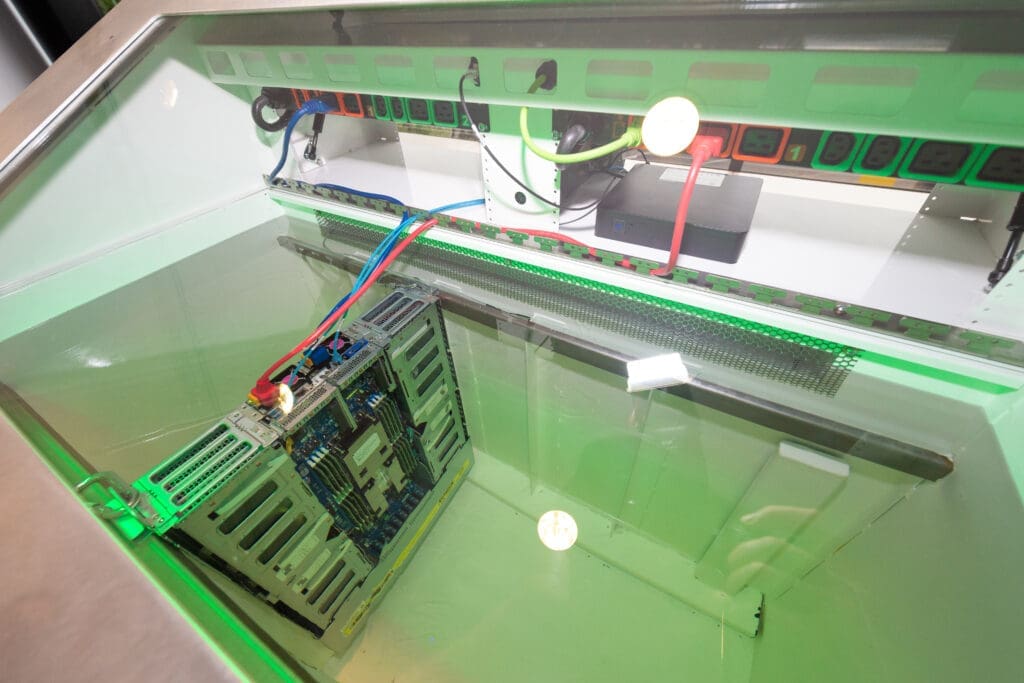Liquid immersion cooling enables next-gen technology to unlock new industries

Adoption, migration, optimisation, security and management services designed to deliver business agility.
Improve your security posture with tailored strategies and front-line defence services.
Scalable colocation and connectivity within a hyper secure environment.
Disaster recovery and serviced offices in secure, premium office facilities.
Tailored end-to-end solutions for your hardware ecosystem across the widest range of vendors.
Seamless management of your IT environment, underpinned by world-class cyber security, no matter where you are on your journey.
Securely and effectively operate, monitor and maintain your network.
Enjoy the comfort of a modern working space supported by world class technology, security and resilience.
Help your clients take control of their IT environment with Australia and New Zealand’s leading hardware maintenance provider.
Interactive Anywhere provides robust infrastructure solutions designed to support the seamless operation of digital environments. These solutions include scalable cloud services, reliable data storage, and efficient server management, ensuring optimal performance and uptime.
The network solutions from Interactive Anywhere encompass comprehensive design, implementation, and maintenance of secure and efficient networks. By optimising connectivity and bandwidth, these solutions facilitate seamless communication and data transfer, enhancing overall productivity and operational efficiency.
Interactive Anywhere offers dedicated end user support services that ensure users receive prompt assistance with technical issues. This includes help desk support, troubleshooting, and training, aimed at improving user experience and minimising downtime for businesses.
With a focus on safeguarding digital assets, Interactive Anywhere's cyber security solutions provide advanced protection against cyber threats. These solutions include threat detection, risk management, and compliance services, ensuring businesses can operate securely and with confidence.
Interactive offers financial institutions with secure operations, robust cyber security, seamless connectivity, end-user support, and cloud solutions, ensuring long-term resilience.
For manufacturing, precision and efficiency are paramount. Our solutions optimise operations, streamline processes, and ensure seamless connectivity to drive productivity and innovation.
In professional services, reliability and agility are crucial. Our solutions enhance efficiency, streamline workflows, and provide seamless connectivity, empowering firms to deliver exceptional client experiences and stay ahead in a dynamic market.
In aged care, precision and patient well-being are fundamental. Our solutions enhance operational efficiency, streamline workflows, and guarantee secure, seamless connectivity, empowering providers to deliver exceptional care and lead in an ever-evolving sector.
We're Australia's leading IT service provider and we keep technology human.
News & insights from our experts to help you drive performance and grow your business.

Australia hosts the Southern Hemisphere’s fastest supercomputers and has made considerable investments in high performance compute (HPC) infrastructure in recent years. While HPC influences all aspects of the Australian economy – according to the Department of Industry, Science and Resources – we are still considered a contributor to the global HPC community, rather than a world leader.
What will it take to make the next technological leap? So we confidently stand alongside those that have traditionally been at the forefront of HPC such as the United States, China, Japan, France, and the United Kingdom.
To break through the next barrier, we need data centre cooling solutions that support the full capacity of our hardware. Immersion cooling has emerged as a promising solution that offers several benefits compared to traditional cooling methods.
Immersion cooling involves submerging hardware components such as HPC servers in a non-conductive liquid that acts as a coolant. This liquid transfers the heat generated by the components and carries it away from the hardware.

Unlike traditional cooling methods that rely on air to dissipate heat, immersion cooling is more than 1200 times more effective than air at transferring heat. This allows for higher cooling efficiency and significant energy savings as the coolant can operate at around 40°C and can operate with a condenser water loop and simple dry cooler.
Immersion cooling supports the new generation of CPU’s and GPU’s used in HPC servers with much higher power densities. Traditional cooling methods require large amounts of space for cooling systems such as CRAC units, raised floors , chillers and supporting infrastructure. Because of the much improved Data Centre energy efficiency all of the supporting switchboards, Generators , etc can be significantly smaller. This can be particularly important for data centres and other facilities where space is at a premium.
This means we can have more computing power in a smaller space, operating at a higher intensity, for a longer period.
HPC systems require powerful processors, graphics cards, and other components that generate a lot of heat. Traditional cooling methods are often unable to cope with the heat generated by HPC systems, limiting their performance. Immersion cooling, on the other hand, can efficiently cool these components, allowing them to operate at their full design potential without any throttling of components.
With recent developments in artificial intelligence (AI) bringing the notion of neural networks and machine learning to the mainstream, it will come as no surprise that the hardware required to operate generative adversarial networks needs a superior cooling solution – the old fan-powered air cooling won’t cut it.
Given the growing pressure on governments and industries to address their climate impact, immersion cooling offers an elegant solution. By reducing energy consumption that would otherwise be used to constantly circulate air, it can help reduce carbon emissions and mitigate the impact of climate change. This is cost effective, too – the average immersion cooling tank uses around 30 per cent less energy than traditional cooling methods.
While immersion cooling is great for the technology of today, what’s really exciting is its potential to unlock the technology of tomorrow. Humanity’s greatest problems are being solved using HPC – the cutting edge of calculation and data analysis – and Australia is at the centre of it all.
Using HPC, Australian researchers have done incredible work in genomics, mapping out the patterns and science behind cancer in the hope of reverse engineering a cure. We’ve taken great strides in climate science, with the Australian Bureau of Meteorology using HPC to improve weather forecasting simulations for a range of industries, including agriculture, aviation, and emergency services.
This provides an opportunity that Australia must seize. As a nation that prides itself on punching above our weight when it comes to science and technology, we must embrace immersion cooling as something that can enable Australia to achieve its research goals and stay competitive in a rapidly changing world.
Our fledgling space industry will be relying on HPC to plot astrogation and orbital dynamics. Our research and science industries will use massive computing power to analyse and solve problems for everything from medicine and biology, to chemical engineering, through to urban planning and large-scale population modelling.
Australia is at the epicentre of this new technology adoption. The APAC region is set to be the world’s largest consumer of immersion cooling solutions and is expected to dominate the global high-density rack market. This is due to high investment in research and development activities, and to the growing need for robust data centres for cloud computing in different verticals.
Speaking to one our partners, it’s clear that immersion cooling is the future of supercomputing.
“It’s the way of the future – probably one of the biggest leaps in terms of cooling technology that we’ve seen as an industry. It’s an enabler for everything else, breaking the chains that have held us back and letting us really lean into the next stage of computing.” - Freya Yu, Sales Director, Giga Computing
Immersion cooling is a critical technology for Australia’s research capabilities. It will unlock the full potential of high performance computing, enable more compact and dense hardware configurations, and enable new technologies and applications.
Now is the time to adopt immersion cooling, to put Australia at the forefront of research and development, enabling us to tackle some of the world’s most pressing challenges.
Learn more: https://www.interactive.com.au/services/data-centres/solutions/high-density/